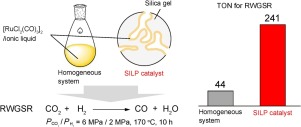Applied Catalysis B: Environment and Energy ( IF 22.1 ) Pub Date : 2018-03-21 , DOI: 10.1016/j.apcatb.2018.03.057 Tomohiro Yasuda , Eriko Uchiage , Tadahiro Fujitani , Ken-ichi Tominaga , Mayumi Nishida

|
The reverse water–gas shift reaction (RWGSR) using a supported ionic liquid-phase (SILP) catalyst consisting of Ru catalyst, ionic liquid (1-butyl-3-methylimidazolium chloride ([C4mim]Cl)), and porous silica gel support, was investigated. The catalytic activity of the SILP catalyst toward RWGSR strongly depends on the kind of Ru catalyst and amount of IL. Among the three kinds of Ru catalysts ([RuCl2(CO)3]2, Ru3(CO)12, and RuCl3), [RuCl2(CO)3]2 exhibits the best catalytic activity. Brunauer–Emmett–Teller (BET) surface area analysis and diffuse reflectance infrared Fourier transform spectroscopy (DRIFTS) analyses of the SILP catalyst based on [RuCl2(CO)3]2 and [C4mim]Cl revealed that both the solvation of the active catalytic Ru species and the surface area of the ionic liquid phase strongly affect catalytic activity. Hence, these factors help to determine the optimum amount of [C4mim]Cl in the SILP catalyst. The resulting SILP catalyst, with an optimum constitution, exhibited greater catalytic activity than the homogeneous system in which the same amounts of [RuCl2(CO)3]2 and [C4mim]Cl were employed. Catalytically active Ru species during RWGSR in both systems were investigated by means of electrospray ionization-mass spectrometry (ESI-MS). Interestingly, the rate-determining step in the two systems was different, implying that the silica support lowers the activation energy of the protonation reaction in the catalytic cycle. Therefore, the facilitation of the RWGSR by a SILP catalyst system can be realized by good mass transport, derived from the large surface area, as well as the effect of the silica support on activation energy. Furthermore, 20 cycles of the RWGSR using the SILP catalyst were accomplished.
中文翻译:

使用负载型离子液相催化剂的水煤气逆反应
使用负载型离子液相(SILP)催化剂的逆水煤气变换反应(RWGSR),该催化剂由Ru催化剂,离子液体(1-丁基-3-甲基咪唑鎓氯化物([C 4 mim] Cl))和多孔二氧化硅组成凝胶支持物进行了研究。SILP催化剂对RWGSR的催化活性在很大程度上取决于Ru催化剂的种类和IL的量。在三种Ru催化剂([RuCl 2(CO)3 ] 2,Ru 3(CO)12和RuCl 3)中,[RuCl 2(CO)3 ] 2表现出最好的催化活性。基于[RuCl 2(CO)3 ] 2和[C 4 mim] Cl的SILP催化剂的布鲁诺尔-埃默特-泰勒(BET)表面积分析和漫反射红外傅里叶变换光谱法(DRIFTS)分析表明,两者的溶剂化活性Ru的种类和离子液相的表面积极大地影响了催化活性。因此,这些因素有助于确定SILP催化剂中[C 4 mim] Cl的最佳量。与具有相同量的[RuCl 2(CO)3 ] 2的均相系统相比,具有最佳结构的所得SILP催化剂表现出更大的催化活性。和[C 4 mim] Cl被使用。通过电喷雾电离质谱(ESI-MS)研究了两个系统在RWGSR期间的催化活性Ru物种。有趣的是,两个系统中的速率确定步骤不同,这表明二氧化硅载体降低了催化循环中质子化反应的活化能。因此,SILP催化剂体系对RWGSR的促进作用可以通过良好的质量传递来实现,这种质量传递源于较大的表面积,以及二氧化硅载体对活化能的影响。此外,使用SILP催化剂完成了20个循环的RWGSR。



























 京公网安备 11010802027423号
京公网安备 11010802027423号